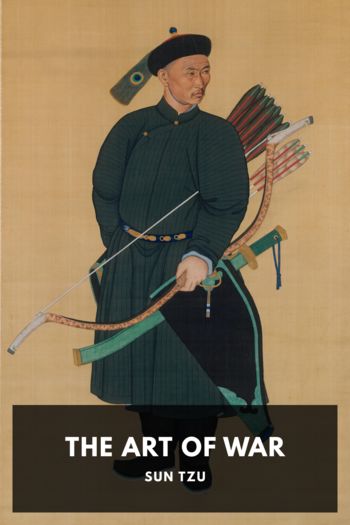The Art of War by Sun Tzu (elon musk reading list TXT) 📕

- Author: Sun Tzu
Book online «The Art of War by Sun Tzu (elon musk reading list TXT) 📕». Author Sun Tzu
But once refer the work to the 5th century or earlier, and the chances of its being other than a bonâ fide production are sensibly diminished. The great age of forgeries did not come until long after. That it should have been forged in the period immediately following 473 is particularly unlikely, for no one, as a rule, hastens to identify himself with a lost cause. As for Yeh Shui-hsin’s theory, that the author was a literary recluse,73 that seems to me quite untenable. If one thing is more apparent than another after reading the maxims of Sun Tzǔ, it is that their essence has been distilled from a large store of personal observation and experience. They reflect the mind not only of a born strategist, gifted with a rare faculty of generalization, but also of a practical soldier closely acquainted with the military conditions of his time. To say nothing of the fact that these sayings have been accepted and endorsed by all the greatest captains of Chinese history, they offer a combination of freshness and sincerity, acuteness and common sense, which quite excludes the idea that they were artificially concocted in the study. If we admit, then, that the 13 chapters were the genuine production of a military man living towards the end of the “Chʽun Chʽiu” period, are we not bound, in spite of the silence of the Tso Chuan, to accept Ssǔ-ma Chʽien’s account in its entirety? In view of his high repute as a sober historian, must we not hesitate to assume that the records he drew upon for Sun Wu’s biography were false and untrustworthy? The answer, I fear, must be in the negative. There is still one grave, if not fatal, objection to the chronology involved in the story as told in the Shih Chi, which, so far as I am aware, nobody has yet pointed out. There are two passages in Sun Tzǔ in which he alludes to contemporary affairs. The first is in VI:—
Though according to my estimate the soldiers of Yüeh exceed our own in number, that shall advantage them nothing in the matter of victory. I say then that victory can be achieved.
The other is in XI:—
Asked if an army can be made to imitate the shuai-jan, I should answer, Yes. For the men of Wu and the men of Yüeh are enemies; yet if they are crossing a river in the same boat and are caught by a storm, they will come to each other’s assistance just as the left hand helps the right.
These two paragraphs are extremely valuable as evidence of the date of composition. They assign the work to the period of the struggle between Wu and Yüeh. So much has been observed by Pi I-hsün. But what has hitherto escaped notice is that they also seriously impair the credibility of Ssǔ-ma Chʽien’s narrative. As we have seen above, the first positive date given in connection with Sun Wu is 512 BC. He is then spoken of as a general, acting as confidential adviser to Ho Lu, so that his alleged introduction to that monarch had already taken place, and of course the 13 chapters must have been written earlier still. But at that time, and for several years after, down to the capture of Ying in 506, 楚 Chʽu and not Yüeh, was the great hereditary enemy of Wu. The two states, Chʽu and Wu, had been constantly at war for over half a century,74 whereas the first war between Wu and Yüeh was waged only in 510,75 and even then was no more than a short interlude sandwiched in the midst of the fierce struggle with Chʽu. Now Chʽu is not mentioned in the 13 chapters at all. The natural inference is that they were written at a time when Yüeh had become the prime antagonist of Wu, that is, after Chʽu had suffered the great humiliation of 506. At this point, a table of dates may be found useful.
BC 514 Accession of Ho Lu. 512 Ho Lu attacks Chʽu, but is dissuaded from entering 郢 Ying, the capital. Shih Chi mentions Sun Wu




Comments (0)